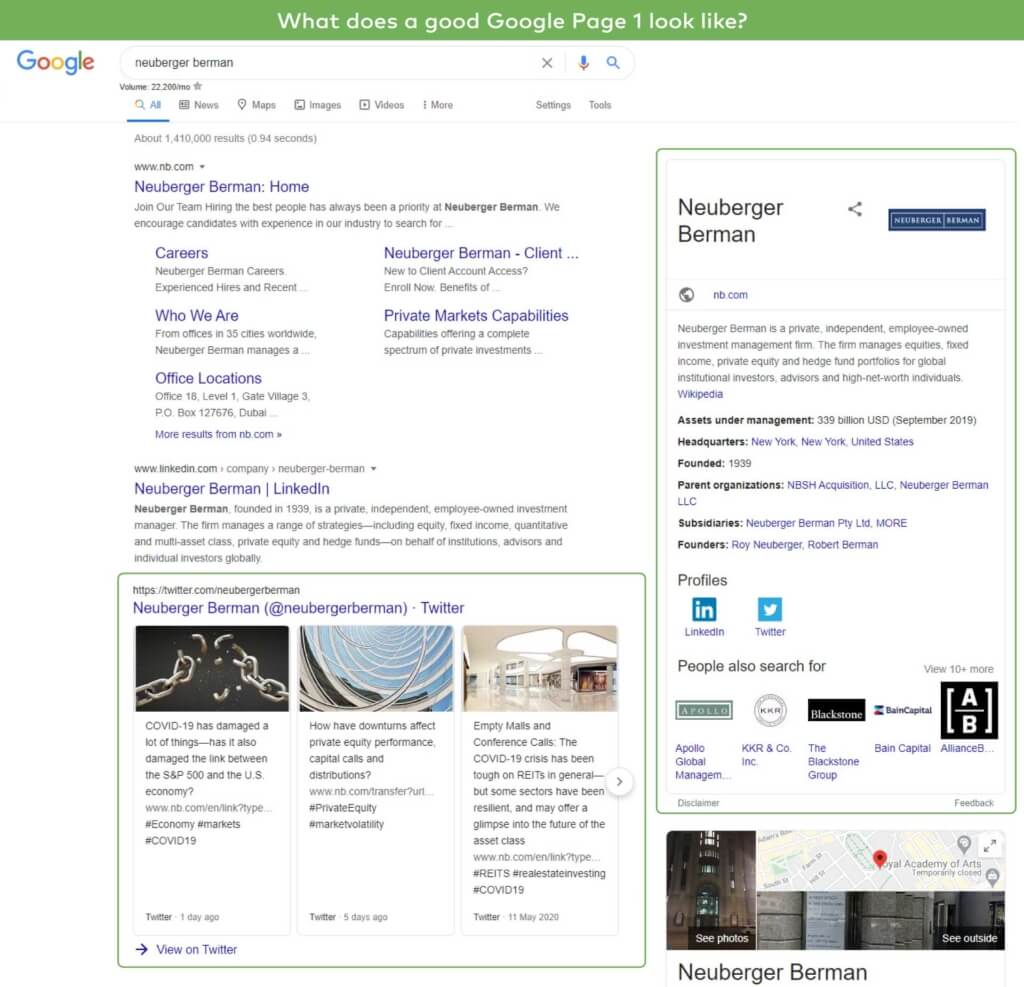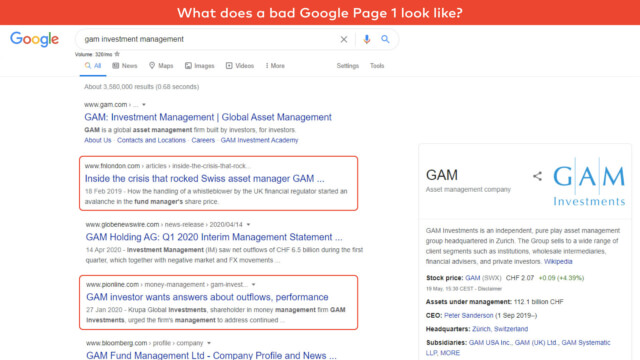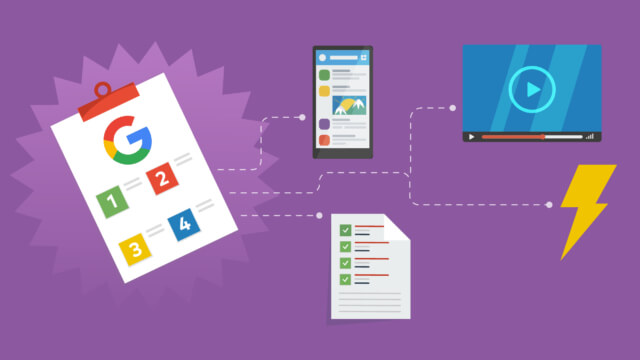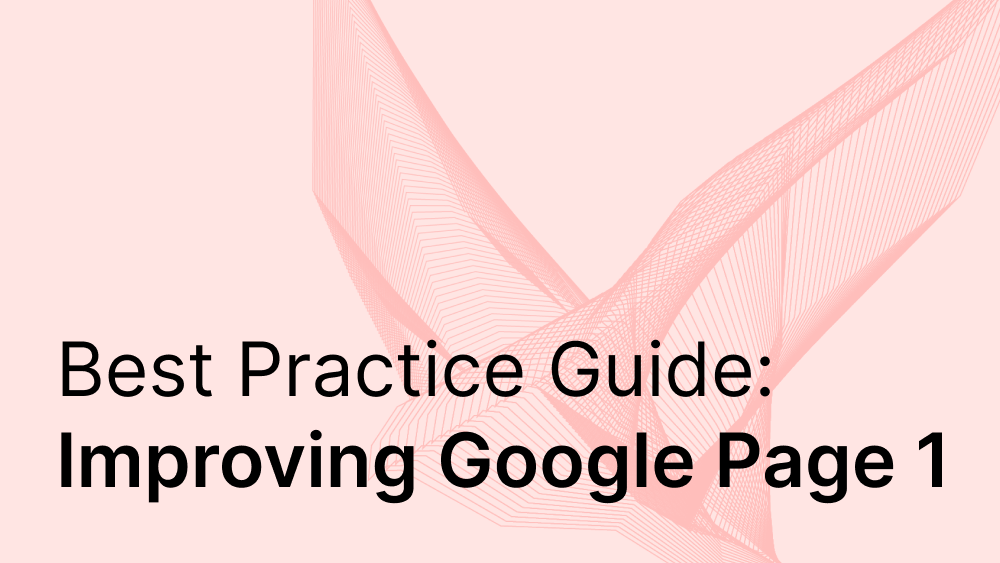If an investor or customer were to Google you right now, what would they find out about you? Is it positive – or reputationally damaging?
Every year, we conduct this exact test to see what the top-100 largest asset managers in the world have lurking on their Google Page 1 (GP1) and every year, between 10% and 20% have reputationally damaging results.
Few things matter more than first impressions and GP1 is your corporate brochure. Given the relatively high proportion of managers that are struggling with negative content on their GP1, we’ve decided to lay out a guide detailing; what it is, why it matters, the difference between a good and bad GP1, and finally, how to build a fully optimised GP1 strategy. What is Google Page 1?
What is Google Page 1

Google Page 1 is a proprietary metric based, measuring how much content on a firm’s GP1 is owned by the firm, how much of it is positive and the extent to which a firm’s website has been optimised to be referenced multiple times in the Google Search Results Pages. Also how resilient is the content on your current GP1 when faced with a wave of negative third party news, usually coming from the press.
A resilient Google Page 1 is made up of three things:
1. Search Engine Optimisation: encompassing “domain authority,” “backlinks,” “number of visitors,” age of the content, how many times a day you add content to your overall website.
2. Sticky content: content that users actually want to read and come back to after their initial visit. Having a number of articles like this greatly increases the resilience of your Google Page 1.
3. Owned channels: Google gives greater weighting to content from social media channels, for example your corporate LinkedIn and Twitter, and video hosting sites like YouTube.
As marketers, our focus in particular needs to be on content – as we all know, the currency of the internet is content. SEO and channels support the distribution of our content.
Why does your Google Page 1 matter?
Besides the fact that between 10% and 20% of the world’s largest financial services firms suffer from negative coverage appearing on their GP1, it matters because it’s your firm’s corporate brochure. Google is a research tool for investors, consultants, strategic partners, senior talent and all your other external stakeholders, so you want what shows up to reflect well on your company as much as possible. That first page of Google matters more than any other page. 75% of people don’t scroll beyond the first page, so it’s about first impressions and it’s about the information that sticks with your company over the long term.
It may take several years to get rid of some negative stories, the quickest we’ve seen is 4 days. But there are two critical points here. First, that all content on Google has a half-life and second, that there are actions you can take to reduce that half-life. Ask yourself two questions:
How resilient is your current GP1?
The more channels you own, the more content you’re pushing out and the more popular that content is with Google’s audience, the harder it is for a third party’s content to appear on your GP1. So you can prepare in advance by filling your GP1 with owned channels as much as possible.
How quickly can you get rid of the content once it’s there?
Do you have a strategy in place to clean up your GP1.
The company that got rid of a negative story in 4 days managed to do this because they were so well set up with a strategy, whilst others are completely unprepared and therefore unable to push it down at all.
Good GP1 vs bad GP1
Over the years, we’ve seen negative results like damaging litigation events, high profile sackings of senior management teams, accusations of fraudulent behaviour or damages payments having to be made to people in various cases. These are a few examples, but it is something that keeps coming up with some of the top financial services firms in the world. Here’s a specific example of a firm which scored in the top percentile in our latest Global 100 asset management marketing report vs an example of a GP1 gone wrong:


How to build a Google Page 1 strategy
How to build a GP1 strategy The playbook for ensuring a strong Google Page 1 is in most cases relatively simple but is often not well understood. The confusion tends to emerge, firstly because few people appreciate that maintaining a strong Google page requires a multidisciplinary approach and, secondly, because GP1 is dynamic and continually evolving.

The most common trap asset managers fall into in trying to mitigate negative media coverage on their Google Page 1s is thinking it can be tackled through one channel. Most frequently, the perceived solution is to call in the SEO experts, but the reality is that on its own this approach is unlikely to yield the hoped-for results.
SEO analysis is an important part of the solution, but it will not be very effective unless it forms a trifecta with content and channels. Very simply, if marketers do not have the right content to share and if they do not own the right channels and distribution, then it doesn’t matter how much technical support they have, they will struggle to improve their Google Page 1 score.
The integrated marketing project team ultimately needs to understand how to create engaging, relevant content that will gain traction with social audiences as well as third parties, including journalists, while also distributing and delivering that content in accordance with best practice principles.
With this in mind, developing a strategy to build a resilient GP1 has four core components:
1. A plan to highlight areas for improvement – taking account for any anticipated risks (a major corporate news story) and conduct an audit of your existing assets. Use Google Analytics to shed light on what type of content you already have that’s completing more goals than others, converting better, causing the lowest bounce rates, more user time and the pages that people are entering on rather than leaving on. That’s how you find the content you want to focus your energy on creating.
2. Assets to be created or augmented – by this we mean social media accounts, video content, third party media validations, websites, blogs you own – and backlinks. The crucial issue here is not just having the assets, but making sure Google values these as highly as possible, this means you need strong traffic and engagement to these assets.
3. A content pipeline to feed engagement and boost ranking – content is critical because strong content means your existing GP1 will be more efficient, And it means it will be quicker to dislodge negative news flow or other third party content from your GP1.
4. A response plan to mitigate the effects of negative news – even with a strong GP1, sometimes a negative news story can break into the top search results for your brand. For this reason, a contingency plan is essential and a contingency plan is usually composed of two things:
- Evergreen news or content that can be disseminated quickly and gain traction with your audience.
- A plan for rapidly creating and deploying new assets - e.g. this could be video content which is a useful tactic as video content tends to have high engagement, is highly rated by Google and also takes up more space in search results.
Google Page 1 is one of the most powerful tools in the digital marketing armoury if utilised well. Making it as resilient as possible is even more vital in these times, and to achieve this, marketers need an integrated approach which takes account of the right content, the right channels and the right SEO and distribution. Don’t get caught out, be prepared.
Google Page 1 case studies
GAM Investments
- Wrestling with an embarrassing crisis involving former star fund manager Tim Hayward for some time now.
- However, when it comes to their Google Page 1 their response to this has been to bury their heads in the sand.
- In terms of what they could have done differently, they could have handled the media crisis better to create a stronger media narrative. But secondly, because they own so few assets on their Google Page 1 it gives them fewer levers with which to oust the negative content.
Neuberger Berman
- The website, in contrast with GAM, is well optimised for Google’s bots and therefore has a page by page website breakdown that not only makes it easier for investors to navigate to the right page straight from search, but also means they dominate more space at the top of their Google Page 1.
- There’s a better use of social channels – you can see the content they share over Twitter being featured heavily on their Google Page 1, showing Google is ranking this content quite highly.
- Really importantly, they have a very, very strong roster of positive third party media articles on their Google Page 1 – most firms would be pleased to have one or two, but Neuberger has no less than 5!]


